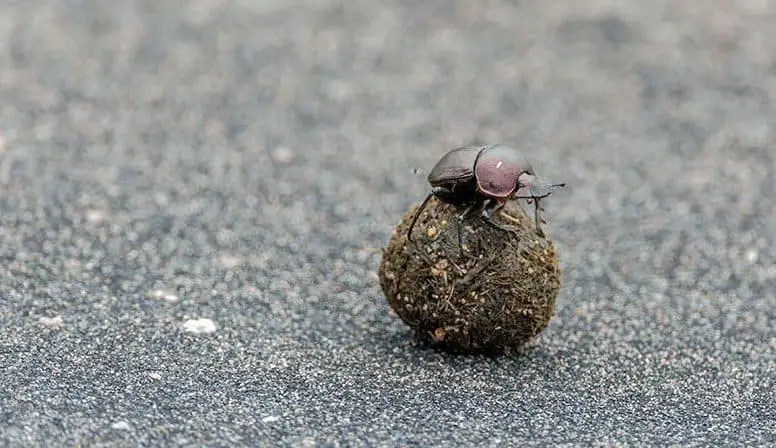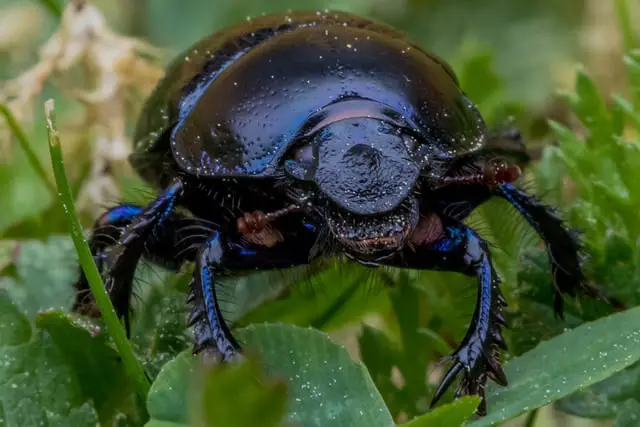Table of Contents
*This post may contain affiliate links. As an Amazon Associate we earn from qualifying purchases.
The Dung Beetle Habitat
While it may not be the cutest or most lovable member of the animal kingdom, the dung beetle is very fascinating. Like most animals, dung beetles have adapted to their appropriate environment over the course of their evolution. Read on to understand who they are, where they live and what they do.
What Is a Dung Beetle?
Class insecta, order coleoptera, family scarabaeidae. This is the scientific classification of the insect better known as the dung beetle. These tiny creatures range in size from 0.5 inches to 2.5 inches and survive by means that most (if not all) humans consider absolutely revolting. The beetles eat dung as in poop. They live in the manure of large animals, and get their required nutrients from these smelly droppings. While it is typical to enjoy the dung of herbivores, some beetles have been found feasting on omnivore waste.
When a large animal eats, the process of digestion takes place deep within the small intestine. Digestion is the breaking down of insoluble molecules into water-soluble molecules, which are subsequently absorbed by the bloodstream.
While the small intestine holds on to most of the nutrients found in these molecules, the bloodstream distributes the rest around the animal’s body for use and storage.
As impressive as the digestive process is, it is not perfect. There are always trace amounts of nutrients that go undigested when an animal eats, and these come out the other end in the form of dung.
The dung beetle finds these droppings and nourishes itself from the undigested, and hence still viable, nutrients. Young beetles often eat solid bits of the dung, whereas adults have been observed to practice a liquid cleanse of sorts, sucking the juice from the dung through a mouthpiece.
Similar to other insects, this beetle is made up of a head, a prothorax and an abdomen. They have six legs, folded wings and wing covers, and can be a number of different colors, though they are typically black.
Such a creature may seem unassuming, but it has been held in great regard throughout history. In fact, in ancient Egypt people viewed dung beetles as incarnations of Khepri, the sun god, and would often have depictions of the beetle etched onto their sarcophagi, providing their resting place with pictures of the sacred scarab. They also painted pictures of dung beetles on pieces of jewelry and art, and in general considered them a holy animal.

Where Does It Live?
The short answer is dung, but this dung can be found in a great variety of places on Earth. Dung beetles currently reside in North America, Europe, Asia, South America, Australia and Africa, in a plethora of climates and biomes. One of the favorite environments for the beetles to reside in is a forest or grassland, but a good rule of thumb is that where there is dung, chances are there are dung beetles.
There are about 90 known species of dung beetle found in North America, and over 500 in Australia. It was Australia that was home to one of the largest dung beetle studies in history. From 1965 to 1985, Dr. George Bornemissza of the Commonwealth Scientific and Industrial Research Organization led a study on cow dung and its effect on the environment.
The Australian Dung Beetle Project, as it was appropriately named, was conceived when Dr. Bornemissza noted a lack of dung beetles in the land Down Under. Cow manure was left untouched, and eventually dried up, killing vegetation nearby, providing a feeding ground for hungry flies and discouraging cows from grazing in the general area, leading to reduced pasture sizes.
Bornemissza decided to introduce dung beetles from places like Europe and Hawaii to Australia, and the results were staggering.
The beetles greatly diminished the number of dried-up manure piles, which eventually led to better fertilized soil and less flies, making a much more comfortable environment for the cattle.
Dung beetles are numerous in Africa as well, where a particular species has baffled and amazed scientists. Dung beetles in Africa have developed a navigational system using the stars and the moonlight, making them highly intelligent and very advanced creatures.
When scientists placed hats on the beetles, effectively blocking their view of the sky, they became completely disoriented. They rely on the Milky Way for finding their way around. Elsewhere, dung beetles do just fine with non-astronomical navigation, taking advantage of their fantastic sense of smell to find a great pile of dung for their home.
Seeing as dung beetles provide quite a service to agriculture and livestock alike, many zoos and animal preservation areas have them living in enclosures with large animals. The animals poop a lot, and the beetles do what they do best. In burying the dung, they make a more pleasant living space for the zoo animals and for the soil and vegetation within the enclosure.
These insects tend to get along with most animals they encounter and are thus located near herds or packs where large mammals reside. The one animal they can’t get comfy with is burrowing owls they are seen as tasty snacks to these owls, who use animal droppings as bait for the beetles.
How Does It Live?
Life for dung beetles completely revolves around their source of nutrients and housing dung. In fact, from the moment one takes its first breath, this species of beetle will spend the entirety of its life in constant search for the next best dung. The dung of choice for an expecting beetle is one with plenty of moisture for her young, so rainy season tends to be mating season as well.
A mother beetle will lay between three and 20 eggs in a pile of dung, and the transformation from egg to adult can take anywhere from a month to three years depending on the species. Once fully adult, dung beetles join a group, or pod of sorts, with which to travel, eat, live and reproduce.
While there are an estimated 7,000 species of dung beetle in the world, they can be funneled down into three distinct types of beetle: rollers, tunnelers and dwellers.
Roller beetles roll little balls of dung using their scoop-shaped heads and antennae and bury them a distance away from the pile, either for their female companions to lay their eggs or for a snack later in the day.
In courting a female, the male roller will roll a ball and present it to his romantic interest, who, if in fact interested, will roll on the top of the ball while the victorious male accompanies her. Once a safe spot is found, typically buried underground, the female will lay one egg in each ball she has available and cover them with a gooey mixture of saliva and feces.
The balls in question here can be as large as an apple and can weigh 50 times a beetle’s own body weight. To put this in perspective, this is about equivalent to an average-size adult human rolling a four-ton ball around.
Tunneler beetles make themselves at home deep in the pile of dung. Once the female lays her eggs, both she and the male will sometimes stay with the larvae in an admirable feat of co-parenting.
Dweller beetles are the risk takers of the group, despite being smallest in size. Whereas the other two types typically bury themselves into their residence, whether it be near a nutritious pile of dung or right smack in it, the dweller simply lives on top of the dung. The female lays her eggs exposed on the manure, and the life of the dweller is frequently spent on the exterior of dung pats.

What To Take Away
You’ve just inhaled a lot of information about dung beetles. You learned that they utilize their habitat for survival, as dung is their main source of food and housing. There are many species, a variety of environments to live in, and a whole heap of different ways to use dung.
What good are dung beetles? Are they just weird little insects that do what humans consider the unthinkable? Actually, as seen in the Australian study, dung beetles are some of the handiest recyclers on the planet. By burying dung and taking refuge in it, they help keep manure fresh.
Plants have a much greater opportunity to grow when nourished by a healthy soil with fresh manure rather than a dried-up pile of poop. Furthermore, beetles keep flies out of manure piles, as the flies tend to arrive once the dung has dried up.
When manure stays fresh and buried, flies keep away. In rural parts of Texas, it is estimated that dung beetles bury 80 percent of cow droppings found, which is good because cows typically poop about 10 times a day.
Dung beetles are helpful little creatures for everyone, and luckily, there is no shortage of them in the world. While multiple species are dwindling in numbers or going extinct, it is good to know that the dung beetle is at little risk of endangerment and is staying strong in numbers around the globe.

